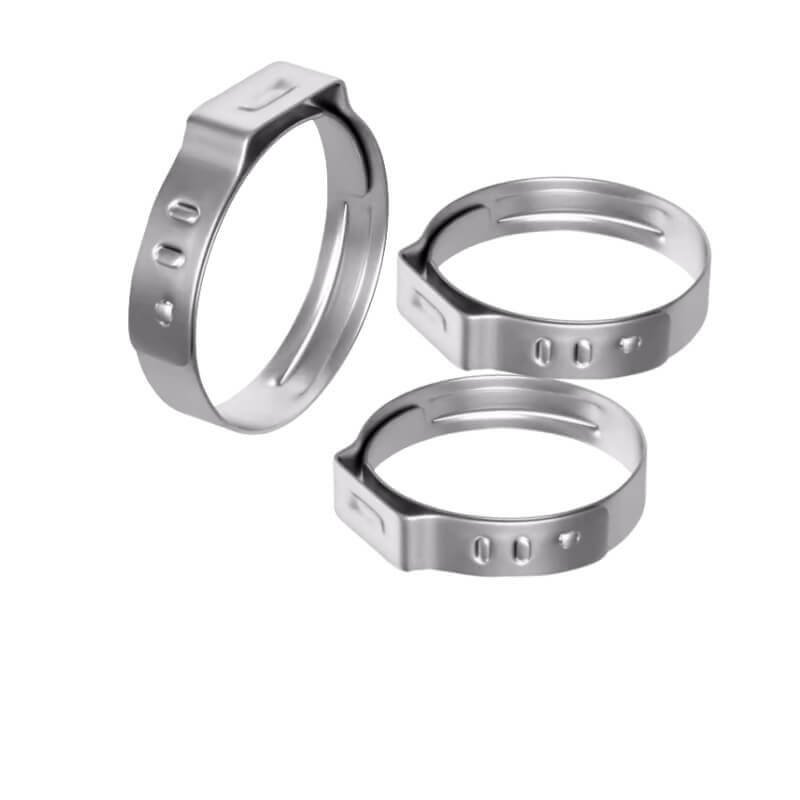Introduction
How to Prevent Hose Clamps from Loosening During Use?
Hose clamps are critical components in automotive, industrial, plumbing, and HVAC systems, ensuring secure connections between hoses and fittings.
However, one of the most common issues users face is clamps loosening over time, leading to leaks, pressure loss, and even system failures.
Vibration, thermal expansion, improper installation, and material fatigue can all contribute to this problem.
Fortunately, there are proven methods to prevent hose clamps from loosening during use.
This article explores the causes of loosening, best practices for secure installation, and advanced solutions to keep clamps tight and reliable.

Why Do Hose Clamps Loosen?
How to Prevent Hose Clamps from Loosening During Use?
Understanding the root causes helps in selecting the right prevention methods. Common reasons include:
1. Vibration and Movement
-
Engines, pumps, and machinery generate constant vibrations.
-
Over time, screws on worm gear clamps can unwind.
2. Thermal Cycling (Heat & Cold Expansion)
-
Metal expands when hot and contracts when cold.
-
Repeated cycles can gradually loosen clamps.
3. Improper Installation
-
Under-tightening leads to immediate slippage.
-
Over-tightening can strip threads or damage the hose.
4. Material Fatigue & Corrosion
-
Cheap or low-quality clamps lose tension over time.
-
Rust weakens the clamp’s grip.
5. Hose Shrinkage or Swelling
-
Rubber hoses can degrade, shrink, or swell, reducing clamp effectiveness.
Best Practices to Prevent Hose Clamps from Loosening
1. Choose the Right Type of Clamp
Not all clamps are equal—some resist loosening better than others.
| Clamp Type | Best For | Loosening Resistance |
|---|---|---|
| Worm Gear Clamp | General use, low-cost applications | Low (prone to vibration loosening) |
| T-Bolt Clamp | High-pressure systems (turbochargers, fuel lines) | High (stronger grip) |
| Constant-Tension (Spring) Clamp | Automotive cooling systems | Excellent (self-adjusts with temperature changes) |
| Ear Clamp (Oetiker) | Permanent, high-security needs (fuel lines, medical) | Very High (crimped, no screws) |
Recommendation: For high-vibration environments, avoid basic worm gear clamps—opt for T-bolt or constant-tension clamps instead.
2. Proper Installation Techniques
A. Correct Tightening Torque
-
Too loose? Hose slips.
-
Too tight? Hose cracks or threads strip.
-
Solution: Use a torque screwdriver (if specified) or tighten until snug, then add a ¼ turn for security.
B. Positioning the Clamp
-
Install the clamp ¼ to ½ inch from the hose end.
-
Ensure the screw is opposite the bending direction (if applicable).
C. Double-Clamping for Critical Systems
-
In high-pressure or high-vibration setups, use two clamps spaced slightly apart for redundancy.
3. Use Thread-Locking Solutions
A. Nylon-Insert Lock Nuts
-
Some clamps come with locking nuts that resist vibration loosening.
B. Thread Locker (Loctite® Blue 242)
-
Apply a small drop to the screw threads before tightening.
-
Caution: Avoid permanent threadlockers (Red Loctite) unless disassembly isn’t needed.
C. Safety Wire (Aviation/Motorsports Method)
-
Secure the clamp screw with lock wire to prevent rotation.
4. Anti-Vibration Solutions
A. Rubber or Neoprene Washers
-
Placing a rubber washer under the clamp screw can absorb vibrations.
B. Spring-Loaded Clamps
-
These automatically adjust tension as the hose expands/contracts.
5. Prevent Corrosion & Wear
A. Use Stainless Steel Clamps
-
Resistant to rust, unlike cheap galvanized steel.
B. Silicone Grease on Threads
-
Reduces friction and prevents seizing (helps in retightening if needed).
C. Replace Worn Clamps Proactively
-
If a clamp shows rust, stripped threads, or deformation, replace it immediately.
Advanced Solutions for Extreme Conditions
1. Adhesive-Backed Hose Wraps
-
Applying self-fusing silicone tape under the clamp improves grip.
2. Serrated or Ribbed Hose Ends
-
Some hoses have textured ends to enhance clamp grip.
3. Hydraulic Crimping (Ear Clamps)
-
Permanent solution—requires a special tool but won’t loosen.
Signs Your Hose Clamp is Failing
Even with preventive measures, clamps can still wear out. Watch for:
✔ Visible rust or corrosion
✔ Hose slipping under the clamp
✔ Fluid leaks around the connection
✔ Loose or spinning clamp screw
If any of these appear, replace the clamp immediately.
Conclusion
Preventing hose clamps from loosening requires:
✅ Choosing the right clamp type (T-bolt, spring, or ear clamps for critical systems).
✅ Proper installation (correct torque, positioning, and double-clamping if needed).
✅ Anti-vibration methods (thread locker, safety wire, rubber washers).
✅ Regular inspection & maintenance (check every 3-6 months in high-vibration environments).
By following these best practices, you can eliminate leaks, reduce downtime, and extend the life of your hose connections. Whether in automotive, industrial, or plumbing applications, a secure clamp ensures system reliability and safety.
Pro Tip: Keep spare clamps and a torque screwdriver in your toolkit for quick fixes!
